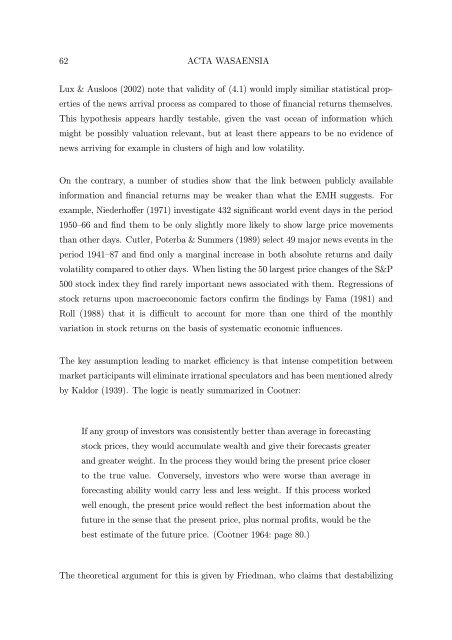BERND PAPE Asset Allocation, Multivariate Position Based Trading ...
BERND PAPE Asset Allocation, Multivariate Position Based Trading ...
BERND PAPE Asset Allocation, Multivariate Position Based Trading ...
You also want an ePaper? Increase the reach of your titles
YUMPU automatically turns print PDFs into web optimized ePapers that Google loves.
62 ACTA WASAENSIALux & Ausloos (2002) note that validity of (4.1) would imply similiar statistical propertiesof the news arrival process as compared to those of financial returns themselves.This hypothesis appears hardly testable, given the vast ocean of information whichmight be possibly valuation relevant, but at least there appears to be no evidence ofnews arriving for example in clusters of high and low volatility.On the contrary, a number of studies show that the link between publicly availableinformation and financial returns may be weaker than what the EMH suggests. Forexample, Niederhoffer (1971) investigate 432 significant world event days in the period1950—66 and find them to be only slightly more likely to show large price movementsthan other days. Cutler, Poterba & Summers (1989) select 49 major news events in theperiod 1941—87 and find only a marginal increase in both absolute returns and dailyvolatility compared to other days. When listing the 50 largest price changes of the S&P500 stock index they find rarely important news associated with them. Regressions ofstock returns upon macroeconomic factors confirm the findings by Fama (1981) andRoll(1988)thatitisdifficult to account for more than one third of the monthlyvariation in stock returns on the basis of systematic economic influences.The key assumption leading to market efficiency is that intense competition betweenmarket participants will eliminate irrational speculators and has been mentioned alredyby Kaldor (1939). The logic is neatly summarized in Cootner:If any group of investors was consistently better than average in forecastingstock prices, they would accumulate wealth and give their forecasts greaterand greater weight. In the process they would bring the present price closerto the true value. Conversely, investors who were worse than average inforecasting ability would carry less and less weight. If this process workedwell enough, the present price would reflect the best information about thefuture in the sense that the present price, plus normal profits, would be thebest estimate of the future price. (Cootner 1964: page 80.)The theoretical argument for this is given by Friedman, who claims that destabilizing
















